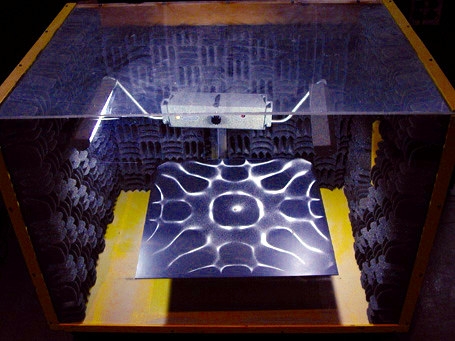What it shows:
A large square metal plate, supported and harmonically driven at its center, is made to vibrate in any one of its numerous normal modes of vibration. As with the regular Chladni Plates, the two-dimensional standing wave patterns are made visible by sand accumulating along the nodal lines. What is different in this demonstration is that a multitude of resonances (across the entire audio range and lower ultrasonic frequencies) can easily be excited. Being a two-dimensional oscillator, the various resonance frequencies are not simply multiples of the fundamental, as are the harmonics in a one-dimensional system.
How it works:
The metal plate is made of 1/8" thick brass and measures 21" square. It is supported in the middle and driven (vertically) by a 3/8" diameter rod, which in turn is part of a electro-mechanical transducer. 1 The transducer is powered by an audio power amp having at least 60 watts of output. 2 The sinusoidal input signal is provided by a function generator with a reasonably fine frequency control. 3
Tuning for the resonance frequencies should be practiced before lecture -- the resonances are very sharp and each one requires adjusting the amplitude for maximum effect and minimum distortion. To save time in lecture hunting for resonances, make a list of the frequencies whose patterns meet your fancy and use a frequency counter to zero in on them quickly. The following are some suggested frequencies, the bold ones having particularly unusual patterns: 334, 839, 1452, 1560, 1823, 3154, 3406, 3595, 4176, 4338, 4754, 5408, and 6500 Hz. But there are dozens of other resonant frequencies which can be tried if you have time. Pictures of some of these patterns are available in our files.
The resonating tones emitted by the vibrating plate are rather loud and piercing (especially the higher frequencies) and so we have enclosed the entire apparatus (excluding electronics) in a large plywood box (41"×28"×28"). For viewing, the front and top of the box are 1/4" thick Plexiglas while the remaining three sides are covered with sound-absorbing foam. 4 Two fluorescent lamps illuminate the Chladni plate, which has been painted black to provide contrast with the white sand. 5
Setting it up:
The sound-absorbing box sits on a dedicated dolly so that it can simply be wheeled in place. The Chladni plate is large and low enough to be directly visible by a good portion of the lecture hall audience. For the larger lecture halls we additionally use a TV camera/projector 6 to assure visibility to all. Alternatively, we place a large mirror on top of the box, angled at roughly 45°. If the mirror is used, position the entire setup off to the side a bit so as not to block the blackboard. It's a good idea to find some patterns that you like before class instead of hunting around in front of the audience. Write down their respective frequencies and use a frequency counter to help you quickly zero in on them. Some suggestions: 830 Hz (bowtie), 3154 (flower), 3406 and 3595 (radial to circular pattern transition), 4338 (diagonal squares), and 4754 (back to simplicity). But there are scores and scores of patterns, so have fun finding ones to your liking.
Comments:
Some of the patterns are incredible; the complexities and symmetries (or sometimes, lack of symmetry) are amazing. One wonders how the plate can possibly vibrate in some of these configurations! The irregular spacing of the resonance frequencies clearly demonstrates that two-dimensional oscillating systems do not have the simple succession of harmonics that one-dimensional systems do. Note that practically all musical instruments are one-dimensional oscillators. Otherwise an orchestra would sound quite dissonant indeed.
1 The transducer has been salvaged from a large hard-disk drive. It consists of a heavy electromagnet and current coil -- not unlike the magnet/voice-coil arrangement in a loudspeaker.
2 Use either the Hafler DH-200 power amp or Kepco BOP36-5M Bipolar Operational Power Supply/Amp
3 The IEC F34 or Wavetek 164 are good choices.
4 Sonex™
5 The lamp fixtures are actually part of a salvaged copy-stand which neatly fits inside the box.
6 The camera, with a mini-bench top tripod, sits right on top of the box and looks straight down at the plate. Use a 8.5 mm (wide angle) lens to get the entire plate in the picture.
